ATI's Radeon X800 XL 512MB - A toe in the 512MB pool
by Anand Lal Shimpi on May 4, 2005 9:27 AM EST- Posted in
- GPUs
At the end of last year, ATI announced 5 new GPUs, three of which were supposed to be available within a week of the announcement, none of which actually were. One of those GPUs, the X800 XL, was of particular interest as it was ATI's first real answer to NVIDIA's GeForce 6800GT and ATI said that it would be priced a full $100 less than NVIDIA's offering. Of course, that GPU didn't arrive on time either. And when it did, you had to pay a lot more than $299 to get it.
Fast forward to the present day and pretty much everything is fine. You can buy any of the GPUs that ATI announced at the end of last year at or below their suggested retail prices. But, we have another GPU release on our hands, and given ATI's recent track record, we have no idea if we're talking about a GPU that will be out later this month as promised or one that won't see the light of day for much longer.
Today, ATI is announcing their first 512MB graphics card - the Radeon X800 XL 512MB. Priced at $449, ATI's Radeon X800 XL 512MB is identical in every aspect to the X800 XL, with the obvious exception of its on-board memory size. The X800 XL 512MB is outfitted with twice as many memory devices as the 256MB version, but ATI is indicating that there's no drop in performance despite the increase in memory devices. The clock speeds of the X800 XL 512MB remain identical to the 256MB version, at 400MHz core and 980MHz memory. The 512MB version is also built on the same 0.11-micron R430 GPU as the 256MB version; in other words, the GPUs are identical - one is just connected to twice as much memory. Right now, the X800 XL 512MB is PCI Express only.
The board layout and design hasn't changed with the move to 512MB. The power delivery circuitry is all the same. The difference is that now there are twice as many memory devices on the PCB.
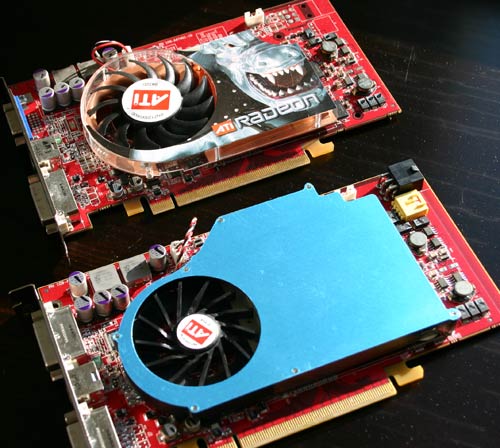
The two X800 XLs: 512MB (lower), 256MB (upper).

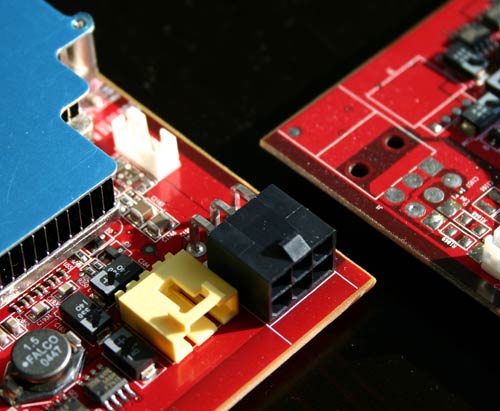
The X800 XL 512MB also now requires the 6-pin PCI Express power connector, something that the original 256MB board didn't need.
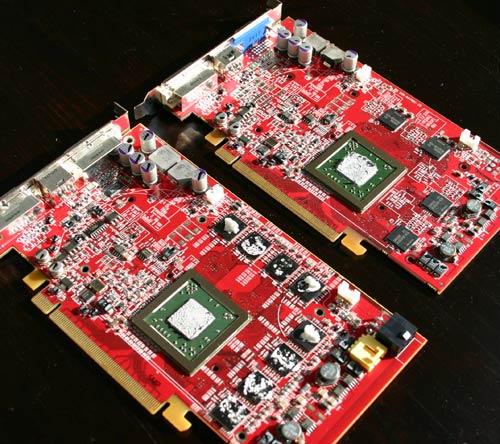
The X800 XL 512MB achieves its memory capacity by using twice the number of chips as the 256MB version.
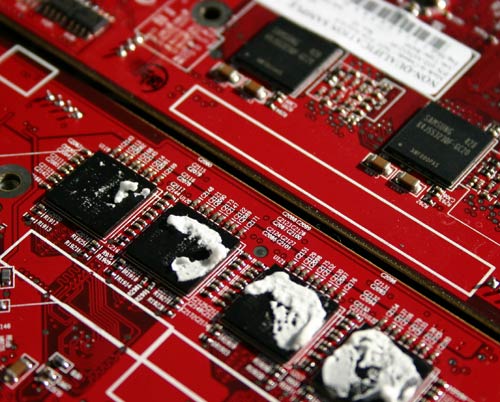
This is where ATI's strategy doesn't seem to make much sense. They are taking a mid-range performance part, the X800 XL, and giving it more memory than any of their GPUs, thus pricing it on par with their highest end X850 XT. More than anything, ATI is confusing their own users with this product. Those who are uninformed and have a nice stack of cash to blow on a new GPU are now faced with a dilemma: $449 for a 512MB X800 XL or $499 for a 256MB X850 XT? That is, if this part does actually ship to market in time and if it is actually priced at $449 - both assumptions that we honestly can't make anymore given what we've seen with the past several ATI releases.
What's also particularly interesting about today's 512MB launch is that ATI won't be producing any 512MB X800 XL cards under the "built by ATI" name. You will only be able to get these cards through ATI's partners. According to ATI, the following manufacturers will bring the X800 XL 512MB to market sometime this month:
- GigabyteAnd as confirmation, here's a slide from ATI's presentation saying the exact same thing:
- TUL
- Sapphire
- HIS
- MSI
- ABIT
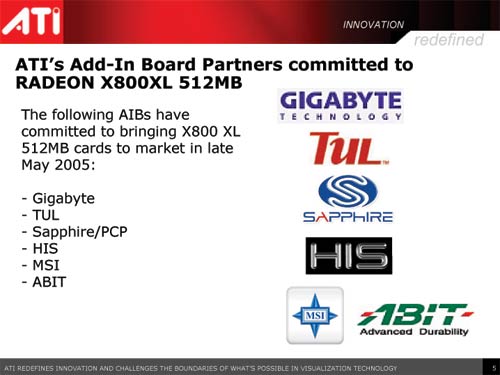
It is worth noting that NVIDIA has been shipping a 512MB card, the 512MB GeForce 6800 Ultra, for quite some time now. However, the card itself only seems to be available to system builders such as Alienware and Falcon Northwest. The 512MB 6800 Ultra is extremely expensive and appears to add around $800 to the cost of any system built by those who carry it; obviously, not in the same price range as ATI's X800 XL 512MB. Despite our curiosities, we could not get a card from NVIDIA in time for this review, although we'd be willing to bet that our findings here with the X800 XL 512MB would apply equally to NVIDIA's 512MB GeForce 6800 Ultra as well.










70 Comments
View All Comments
Houdani - Wednesday, May 4, 2005 - link
ATI has earned your contempt, and deservedly so. Thank you yet again for giving the hardware suits a potent dose of reality.Clearly the games reviewed today are optimized to run on cards with less than 256MB, thereby making the 512MB superfluous. However, the folks above point out that Carmack had other notions in mind -- something which ExtremeTech appears to corroborate. If nothing else, it bears some investigation in order to understand where the difference lies.
LoneWolf15 - Wednesday, May 4, 2005 - link
Originally, Doom 3's recommendation for Ultra High quality mode was a system with a gig of RAM and a 512MB video card so all textures could fit within VRAM. At the time, a 512MB card didn't exist, and 256MB cards were still uber-high technology (Geforce 6800Ultra and Radeon X800XT-PE).I can't think of another game however, where 512MB of graphics RAM is needed, much as articles say "Soon we will". Heck, many people just went from 128MB to 256MB, and smart game developers are going to keep their games at a level where as many systems as possible can run them (which IMO means a Geforce 6600 with 128MB of RAM, or the equivalent). Unless you're running all your games at 1600x1200 (I'm running mostly at 1280x1024 still as I get better monitor refresh rates), I don't see 512MB as being necessary for some time, and even a 128/256MB card will handle most games at that resolution given a fast enough GPU.
mbhame - Wednesday, May 4, 2005 - link
#7: Interesting. I hadn't heard Doom III could use so much System RAM. I don't have a rig capable of touching such resolution, etc. so I couldn't verify personally.I'm gonna check out their article.
ET - Wednesday, May 4, 2005 - link
I don't know. I'm just looking at ExtremeTech's preview of the card, and they get 32FPS for Ultra High mode (with 4xAA and 8xAF) with the 256MB card and 49.3 with the 512MB one. This is opposed to 28.8 and 29.1 for the same at Anandtech.The systems the two used are a bit different, with the Anandtech system having a faster CPU but only 1GB vs. 2GB for the ExtremeTech system. It may be that in this mode Doom3 is so memory hungry that 1GB isn't enough?
mbhame - Wednesday, May 4, 2005 - link
#5: That *is* what Ultra mode does. Ultra mode *is* purely-uncompressed textures and id themselves, if not Carmack himself, claimed you'd need 512MB VRAM to run it all w/o swapping. And that is what was benched in Page 3 of the article.I truly hope I'm misunderstanding or overlooking something.
ET - Wednesday, May 4, 2005 - link
Re #2: yeah, wasn't Doom3 supposed to have a mode that has all textures uncompressed and requires 512MB?Speedo - Wednesday, May 4, 2005 - link
I see no reason to pay extra to get 512MB. #3, I don't think there's even much improvement from 128->256MB.mongoosesRawesome - Wednesday, May 4, 2005 - link
The amount of memory on a card is the most advertised and consequently the most important feature to uninformed consumers. Does 256 MB (vs. 128MB) of memory even matter in resolutions below 1600x1200?Just as with CPU's (clock speed), people want a single measure to judge one GPU against another.
mbhame - Wednesday, May 4, 2005 - link
May I ask why nobody is calling out Carmack on his claims of Ultra *needing* >256MB VRAM when this X800XL 512MB doesn't hardly outperform its 256MB brethren in 1600x1200 Ultra w/4xAA?!?!There is something else afoot - elsewise id's claims are utterly absurd!
So which is it???
erinlegault - Wednesday, May 4, 2005 - link
ATI needs to start acting like the lower cost alternative to Nvidia again. Why would you put 512MB on a 800XL and pay $150 more for no noticable benefit? At least a 512MB X850 XT PE would show more improvement, but they would probably charge $999 for it.